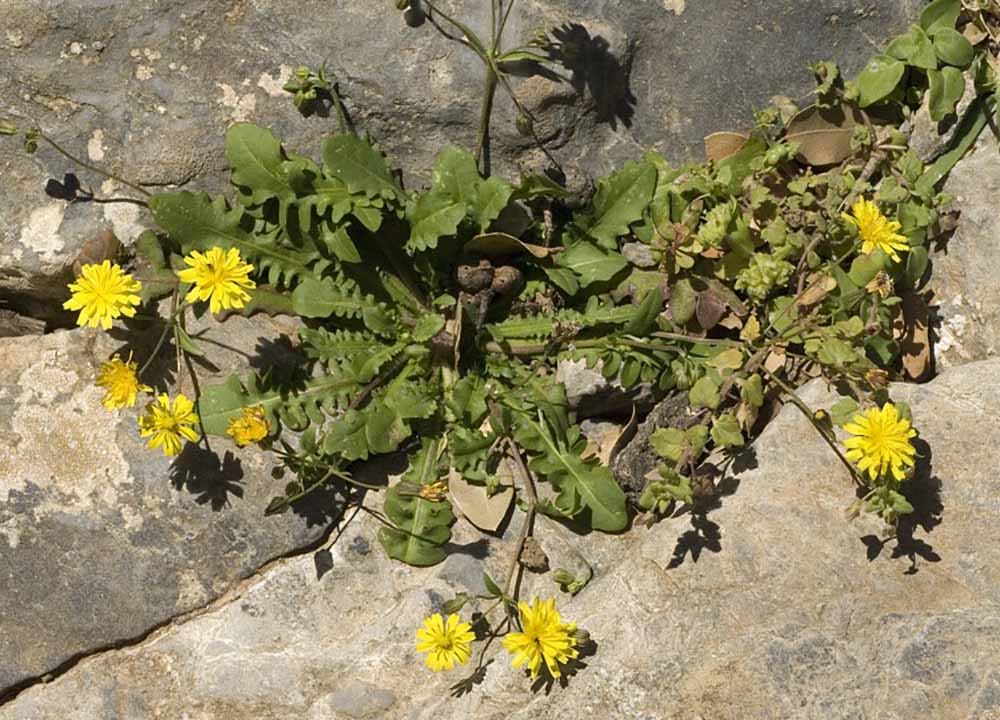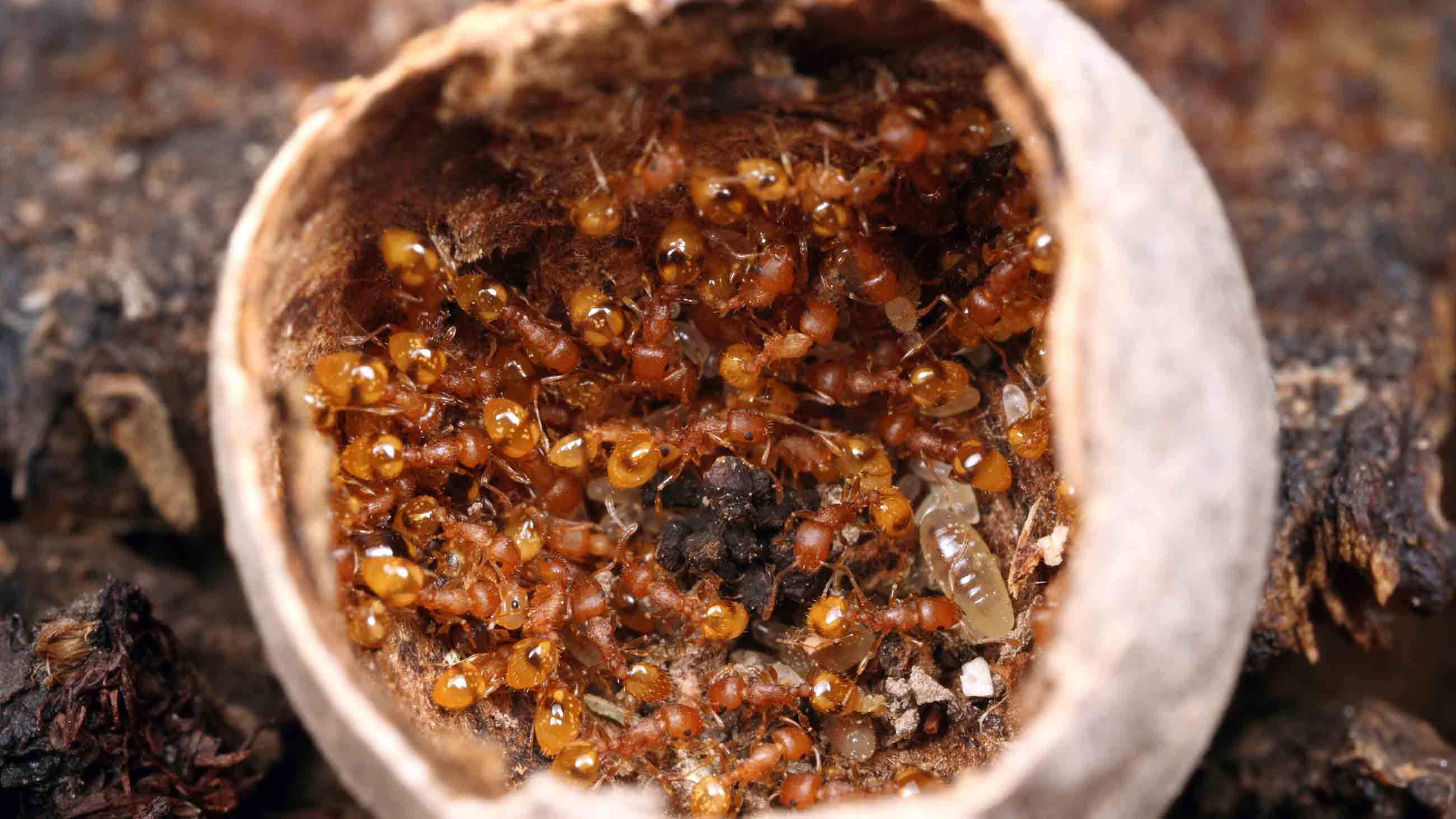What City Ants Can Teach Us About Species Evolution And Climate Change
Acorn ants are tiny. They’re not the ants you’d notice marching across your kitchen or swarming around sidewalk cracks, but the species is common across eastern North America. In particular, acorn ants live anywhere you find oak or hickory trees: both in forests and in the hearts of cities.
That’s why they’re so interesting to Sarah Diamond, a biology professor at Case Western Reserve University in Cleveland. “We’re comparing this little forest island within a city to traditional forest habitats,” she says. Specifically, she and her colleagues are looking at how well city ants can tolerate higher temperatures compared to their rural cousins. The experiment is made possible by what’s known as the urban heat island effect, which describes the tendency of the built-up infrastructure of cities — think heat-absorbing concrete and asphalt, for example — to create a hotter environment than less developed areas.
“The urban island effect is several degrees Celsius warming as you go from rural habitats to urban habitats,” Diamond says. A few degrees may not seem like a huge difference intuitively, but it’s on par with the amount global temperatures are expected to increase over the next decades.
The impact of climate change is something we can’t simulate easily in natural ecosystems, but the artificial environment of cities may provide needed clues. “We can take advantage of this unnatural experiment to see how organisms are responding to altered climatic regimes,” Diamond says.
She and her team collected ant colonies from various sites in the city of Cleveland and in the surrounding countryside of Ohio. They then compared how colonies from each site adapted to the temperature conditions for both urban and rural environments. No matter how they mixed and matched temperatures, Diamond says, “the urban ants always have higher heat tolerance, and they always lose their cold tolerance compared to the rural ants.”
And because ants born in the lab only grow up in that environment, researchers have found that they seem to experience real genetic change, not just a shift in behavior, says Ryan Martin, one of Diamond’s collaborators at Case Western. “You can separate out those acclimatory effects, compared to those effects that are divergent between urban and rural ants [due to] genetic change.” In other words, ants born from urban parents have higher tolerance to heat than ants born in rural environments, even when those newborn ant babies have never experienced the same conditions as their parents.
Diamond and her colleagues see the same effect in ants from places with measurably different climates, including Cincinnati, Ohio; Knoxville, Tennessee; and northern Florida. They’re also expanding their research to include terrestrial isopods (the common critters known variously as pillbugs, sowbugs, and roly polies, among other names). The ultimate goal is to help answer a profound question: Can we predict how well some species will adapt to climate change based on how well they do in cities?
Cities do a lot more than generate heat, of course. They contaminate the soil and air, alter patterns of water drainage and sunlight exposure, radically increase noise pollution, and break up habitats. In the process, they routinely force plants, animals, and microbes to adapt or disappear. And studies have shown that the time scale for these environmental disruptions is astoundingly short compared with the usual rates of change in the natural world.
“Cities are a microcosm of the changes that are occurring at a planetary scale on an urbanized Earth,” says Marina Alberti, professor of urban design and planning at the University of Washington. “Humans in cities are changing the rules of nature’s game. Empirical evidence is showing that we selectively determine which species can live in cities and cause organisms to undergo rapid evolutionary change.”
A number of researchers have become interested in urban ecology because of those relatively fast changes. Most North American cities are less than a century or two old, and the number of humans living in cities has jumped dramatically over the last 100 years. Even though that’s a blink of an eye compared with the history of Earth, eco-evolutionists like Diamond are finding a wealth of measurable differences between urban organisms and members of the same species living in undeveloped ecosystems. Their experiments are beginning to reveal how quickly evolution can act under pressure.
Charles Darwin began “On the Origin of Species” by talking about artificial selection: how humans have bred animals and plants to bring out some features and suppress others. Any number of species have been domesticated, from dogs to pigeons to corn, changing from their wild form into something different. Artificial selection can be extremely rapid, simply by controlling how domesticated species reproduce.
Urban evolution, on the other hand, is still controlled by natural selection. What separates it from “normal” natural selection is that humans are the indirect source of the selection pressures. Our actions restrict nesting spaces by chopping down trees, paving over places for plants to sprout, and driving out some predators while bringing in new ones like cats and dogs. And of course, we raise temperatures by replacing vegetation with concrete, building with heat-absorbing roofs, and introducing greenhouse gases such as ozone from engines.
“Our findings of rapid change of many plants and animals demonstrates the power of natural selection even in our cities,” says Alberti. “Many species will continue to go extinct, but we show that others are evolving the necessary strategies and physical characteristics to coexist with humanity. Understanding the role we play in planetary eco-evolution will provide us with the information to make better decisions and build more sustainable urban settlements.”
But how large and rapid are these changes? And how can we separate fundamental changes in organisms’ makeup due to evolution from behavioral shifts? For instance, city ants haven’t evolved into a distinct species from country ants, even if they still exhibit measurable genetic shifts. Urban-dwelling birds, on the other hand, sing at higher pitches to be heard over the noises of the city. But it’s unclear if that behavior is a genetic change, or if their offspring would resume normal levels of singing if they were raised in the country.
In a recent study in the Proceedings of the National Academy of Sciences, Alberti and her colleagues found more than 1,600 cases from around the world in which urbanization has produced measurable evolutionary effects. Those effects include changes in the size of seeds or offspring, what kinds of food animals eat and where they nest, and how species interact with each other. The cases include plants, invertebrates (insects and so forth), and a range of vertebrates, from fish to birds.


Because of rapid urbanization, these changes occurred on the scale of centuries — or less. By showing the genetic differences between urban and rural acorn ants, Diamond’s experiments in Cleveland revealed that the shift must have occurred since the city began its modern period of growth. That’s roughly 100 years, or about 20 generations of acorn ant queens. And the shift might have been even faster, since we’re only seeing the end result, not the incremental changes since Cleveland began to change into a modern city.
Andrew Hendry of McGill University, one of Alberti’s coauthors on the recent study, says he suspected that the urban heat island effect is less significant than other problems city-dwelling organisms face, such as habitat loss or the breaking up of habitats into small discontinuous pieces. Even so, he added, that doesn’t mean temperature isn’t an important factor: “When it comes to specific things the temperature’s affecting, it can give us some guidelines about how fast can things evolve, what types of organisms can evolve faster or slower, or respond strongly or weakly in respect to temperature.”
In other words, an organism that evolves rapidly in the city might do better in general when trying to adapt to a warming world. “All the weedy, invasive species,” like cabbage white butterflies, “are doing fine,” Diamond says. That’s little consolation, though. Just as cities contain a shadow of the biodiversity of the rural landscape they replace, climate change could result in a cascade of species loss.
“What you find is urban populations have lower [genetic variation],” says Martin. “Presumably, that means they’ve used up some of that variation in evolving, but it also might mean they’ve lost some of their ability to respond [to environmental changes].”
Diamond’s ant lab is dominated by a row of environmental growth chambers. They resemble refrigerators, but their interiors can run the temperature gamut from hot summer days to cold winter nights. She opened one and presented a cup designed to hold urine samples, familiar to anyone who has undergone medical or drug tests. “No one’s peeing in these,” she says. “We’re putting acorn ants in them.”
Inside the cup was an entire living colony of ants crawling around their acorn nest. Each insect is smaller than one eighth of an inch long, with a body so light orange-brown in color it is almost invisible against the acorn. Acorn ant colonies usually have fewer than 100 tiny workers, which explains how they can all fit into a single nut resting in the cup.
Most species aren’t as easy to study as acorn ants. They’re either too big, reproduce too slowly, or don’t survive well under lab conditions. However, by focusing on these tiny creatures and how they survive in living urban laboratories, we may be starting to understand how vulnerable all species are in the uncontrolled experiment known as climate change.
Matthew R. Francis is a physicist, science writer, public speaker, educator, and frequent wearer of jaunty hats. He blogs at Galileo’s Pendulum.










